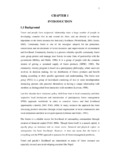Please use this identifier to cite or link to this item:
http://archive.nnl.gov.np:8080/handle/123456789/163| Title: | COMMUNITY FORESTRY AND RURAL LIVELIHOOD IN NAWALPARASI DISTRICT, WESTERN NEPAL |
| Authors: | PAUDYAL, DEVI PRASAD |
| Keywords: | Community based natural resources management |
| Issue Date: | 22-Mar-2019 |
| Abstract: | Community based natural resources management is one of the most effective approaches in achieving the goal of livelihood improvement and environmental conservations. Nepal has been adopting community forest management system for conservation of forest resources and improvement of livelihood of rural people. The dissertation, entitled community forestry and Rural Livelihood has set for objectives such as discussing the forest management practices and policy building process of community forestry in the context of Nepal in general as well as the study area in particular; analyzing the organizational characteristics of community forest user groups in the study area; assessing the linkages between community forestry and livelihood of rural people with special focus on marginalized people and discussing the impact of community forestry and its management issues. This study deals basically with an understanding the linkages community forestry and livelihood phenomena at different ecological regions which established as the central of geographic research. This study has attempted to link different models and concept and socio economic condition by the CFUGs centered perspectives of the study area. Nawalparasi district was selected as the case study area. This district comprises three ecological regions: Middle hill, Inner Terai and Terai with different bio-physical and socio-economic conditions. The study has used both qualitative and quantitative data. Data were collected from both primary and secondary sources. Primary data was collected through observation, focus group discussion, key informant interview, and household survey of the members of community forest. The first objective, discussed about the community forestry is successful in middle hill and inner Terai as compared to Terai. People residing in Terai are affected by traditional users, distance users come far from the southern areas and they want to collect sufficient firewood from forest located in the southern slope of Churia range and adjoining areas. Collaborative forest can be alternative options for those users who reside far from the forest. But collaborative forest is still in the process of development by the government, however, all community forest user groups are not in favour of collaborative forest. vii Secondly, the organizational characteristics of CFUGs in Nawalparasi district have variation as per their situations. Those variations are seen in group size, organizational rules and decision making process. The increasing trend of CFUGs of the study area reveals that there were only nine CFUGs in the period of 1990-1995 after the year of the restoration of the democracy. The numbers of organization is increased by more than 4.5 times within a span of 15 years. Most of the CFUGs have priorities in the fulfillment of basic needs. Twelve CFUGs have placed fulfillment of local needs as their first priority activities. Conservation and management of forest is taken as first priority by eight CFUGs and remaining five CFUGs have taken income generating activities and poverty reduction as first priority. In the third objective, the linkages between community forest and livelihood of rural people have been found different in the different ecological regions especially basic need such as firewood, leaf litter fodder are sufficiently available in middle hill and inner terai as compared to the Terai region in the study area. CFUGs seem to have more satisfied with the product of firewood, timber, fodder, grass and thatching grass in Inner Terai and Middle hills as compared to the Terai. However, they seem to be less satisfied with the products of medicinal plants in all three ecological regions. The members of CFUGs makes money to some extent by selling forest product for their livelihood. CFUGs have supported to develop community development activities such as road, schools, irrigation development and community halls. The income is also used to pay salary of school teachers are made from the income of forest product especially in Middle hill and Inner Terai. Different types of livelihood options are available that are directly or indirectly linked with community forest. Agricultural crops, livestock, vegetable and forests are interlinked to each other. More than sixty percent annual average income in the Terai is achieved from livestock. It is fifty six percent in the Inner Terai and fifty percent in the Middle hill. Agriculture is the second sources of income in all the three ecological regions. The off-farm activities are alternative livelihood options in the study area. Major off-farm activities include small industries, remittance, pension, business and services. Remittance is the major sources of income in the middle hill as compared to Inner Terai and Terai. |
| URI: | http://103.69.125.248:8080/xmlui/handle/123456789/163 |
| Appears in Collections: | 300 Social sciences |
Files in This Item:
| File | Description | Size | Format | |
|---|---|---|---|---|
| PHD Thesis _after external comments.pdf | 5.83 MB | Adobe PDF |  View/Open | |
| Cover COMMUNITY FORESTRY AND RURAL LIVELIHOOD IN NAWALPARASI DISTRICT.pdf | 394.53 kB | Adobe PDF |  View/Open |
Items in DSpace are protected by copyright, with all rights reserved, unless otherwise indicated.